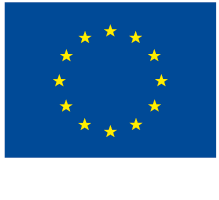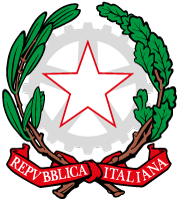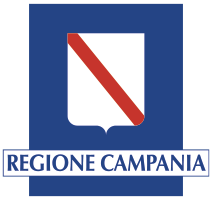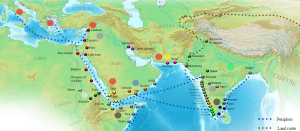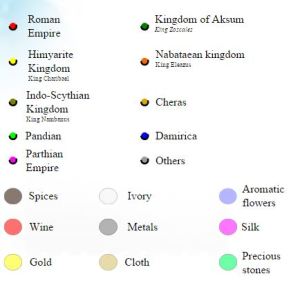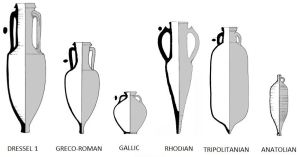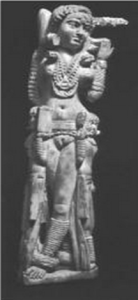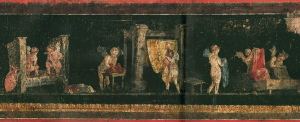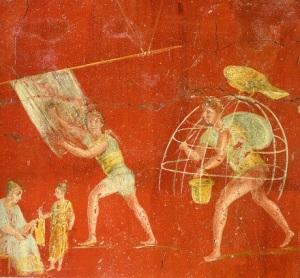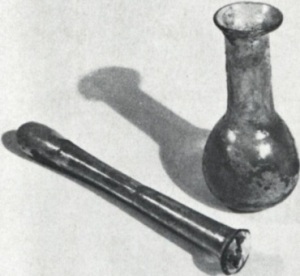TRADE ROUTES AND COMMERCIAL PRODUCTS OF ROMAN POMPEII
TRADE ROUTES AND COMMERCIAL PRODUCTS OF ROMAN POMPEII
ACROSS THE MEDITERRANEAN AND DISTANT LANDS
Contrattista: Dott.ssa Bükra Kalayci
Tutor: Prof. Carmine Gambardella
In the framework of the research-project elaborated by Carmine Gambardella and published in the Atlante di Pompei (2012), this review focus on commercial products and trade routes connected with Pompeii, as an important temporal reference for Roman World (1). Distribution of commercial products within Roman Pompeii is determined as main focus area to investigate. With that aim, export and import actvities of ancient merchants, particularly of Pompeian traders’ are investigated through an explanatory list of commercial products. This research paper employs; the Periplus of the Erytheranean Sea, Pliny the Elder’s Encyclopedia Natural History and elemental analyses of some of the archeological researches to establish possible ancient trade route followed by merchants. The research set light to the nature of Italian trade and consumerism habits in the 2nd century B.C.– A.D. 79.
INTRODUCTION
Pompeii and Herculaneum are located in Italian region of Campania. Two of the ancient towns were buried under the ash by explosion of the Mount Vesuvius in A.D. 79. The cities have been virtually very well preserved in the layer of volcanic ash and stayed untouched until their rediscovery in the 18th century. Their excellent preservation gives archeological researchers a rare opportunity for a deeper understanding of their inhabitants’ social, political and economic lives. Findings in Pompeii, Herculaneum, and the surrounding region have provided researchers a myriad of information not only about Campania region but also about the life in the early Roman Empire (2).
Before examining the commercial potency of Pompeii, its strategic location needs to be stated. Pompeii was the entrepôt for the Sarno river valley and very well connected with other river towns. According to Frederiksen (1984), towns in Campania, incluiding Capua, Cumae, Neapolis, Pompeii and Puteoli, formed a single socio-economic unit (3). The luxury villas of the Bay of Naples, on the other hand, created a great economy in the area (4). The port of Puteoli played a very important role as being one the most important ports of Rome. It was where products from Pompeii, Roman towns and beyond empire came together for further distribution (5). As a result of this, Pompeii took advantage of being in a close proximity to the port of Puteoli.
As a reason of very favourable mild climate and higly fertile volcanic soil, agriculture turned into a commonly practiced industry in Campania region. Pompeii, on the other hand, into a trade center. Pompeians lived a prosperous life and depicted their wealth onto the wall paintings, as shown on the Figure 1, the painting which was found in the House of Vetti. The painting illustrates that Priapus weighs his huge phallus, which was a symbol of wealth in Pompeii, against a bag of coins (6).
Figure 1. A painting of Pariapus, depicting wealth, founded in the House of Vetti, Pompeii (5).
The Pompeian area was rich in typical Mediterranean food products, incluiding olive, olive-oil and wine. Remains from Pompeii show that the inhabitants ate a lot of vegetables, fruit, bread, olives, cheese, lentils, chickpeas. These frequently consumed foods were the ones traded routinely. We should also note that, beans, melons, almonds, and nuts were found in the houses of Pompeii. Beside agriculture, due to the close proximity of Pompeii to the seaside, fishing industry was also enhanced. Consequently, agricultural products were the most sold items but also handcrafts and luxury products had a great importance in the sense of trade (5).
In the surrounding fields of Pompeii there was a great production of oil, wine, cereals, fruit and vegetables. Pompeii hosted the mercants coming from other towns in its termopolum (consists of inns and taverns) where foreigner mercants could buy wine, eat and also have sexual experiences with female slaves (5). Researches point out that trade was very important for the economy of Pompeii, in fact there were many shops and inns which reflects the importance given to commercial activities. According to researchers, Carandini, ed. 1977; Bonghi Jovino, ed. 1984; Laurence 1994, Pompeii, was a city that meets its needs both by locally produced goods as well as by imported goods all along the Mediterranean basin and beyond (7).
Wall paintings and written findings in the houses of Pompeii reveal scenes from everyday life in the first century B.C. until 79 A.D (8). Excavation works at Pompeii produced thousands of goods. Some of the excavated goods were local and some were from other parts of Italy or even beyond Italy. All these excavated commercial goods, objects and any other sort of findings provide us with the idea of economy in Pompeii and lead us to trace ancient trade patterns (9). Pompeii was a city produced goods both for local needs and for exportation. In fact, the economy of Pompeii was mostly based on small-scale workshops. Pompeii hosted a number of small-scale workshops to produce finished goods. Even though the amounf of these products were not massive, they were traded over long distance (10).
This paper basicly focuses on the commercial life in Pompeii which covers the period of 150 BC- AD 79. The range of traded products in these early Roman times and their trade route are investigated. Important commercial ports and products will be emphasized. Significant findings from Pompeii, for example a pottery assamblage, will lead us to have an insight about commercial relations.
TRACING ANCIENT TRADE ROUTE
A wide range of excavated objects like amphorae, paintings, texts, Peripluses are observed by researchers in order to discover the ancient trade routes, commercial and social relations of ancient civilizations. In this research paper, the information about ancient trade routes and traded products is mostly gathered from the Periplus of the Erytheranean Sea, excavated amphorae, Pompeian wall paintings and Pliny the Elder Elder’s encyclopaedia.
A Periplus is a manuscript document that lists the ports and coastal landmarks, with distances, for the navigation of maritime voyage (11). In other words, a periplus, is a systematic catalogue indicates trade contacts in detail (12). There are several surviving periplus to our contemporary time which provide the most extensive and credible evidence for trade of ancient civilizations. The Periplus of the Erytheranean Sea is probably the most important merchant handbook consisting of 66 concise paragraphs that supplies comprehensive information from Roman Egypt ports to the ports in East Africa, Southern Arabia and Western cost of India (10,12). The Periplus of the Erythraean Sea was written by unnamed Romanized Alexandrian author in the first century A.D. The Periplus of the Erytheranean Sea provides with the shoreline information of the Red (Erythraean) Sea, starting from the port of Berenice to further beyond the Red Sea, the manuscript describes the coast of India as far as the Ganges River and the East coast of Africa (called Azania) (13). In addition to comprehensive maritime information within the Periplus of the Erytheranean Sea, the author also presents practical information gathered from different trade voyages such as commercial opportunities along the Eastern coast, list of exported commodities and amount of certain goods and their origin (14).
Beside Periplus of the Erytheranean Sea, Pliny the Elder’s encyclopaedia “Natural History” is another compelling resource. Pliny the Elder was born in northern Italy in around A.D. 23, moved to Rome for eductaion and served for the Roman army. Later Pliny the Elder served as an advisor to the Eperor Vespanian and developed an academic interest in naval matters. He was given the prefecture of Roman fleet at Misenum in the Bay of Naples and he held his notes until his dramatic death in A.D. 79 by the eruption of Vesuvius. The Natural History is a comprehensİve book consisting of wide range of eclectic knowledge; considering the topics like geography, plants, animals, medicines, metals. The book is accepted as an important document for understanding the interest of Roman Society and the cultural attitudes of its elite. It presents details concerning distant commerce relations of Roman merchants and commercial products which are particularly luxury ones that Roman elite consumed (12).
After seizing Alexandria and defeating Cleopatra, Egypt entirely became a Roman province. Later on systematic improve acquired by the emperor Augustus. Irrigation cannals and transport infrastructures enhanced. This improvement followed by a great thrive in agricultural economy and logistic in Roman Egypt. Especially growing and transporting grain. Roman army supplied high security along the trade routes, both for desert and water travels to make merchants feel confident without any fear or threat to their valuable goods. Roman army also upgraded desert routes which facilitated merchants to reach to the Red Sea Ports. After having secure travel conditions in Egypt, more than a hundred extra commercial vessels were annually reaching to India. Conditions also allowed increase in Greek trade activities with east Africa. Improved commercial activities enriched Roman society and resulted in price inflation and increase weath that were later spent on exotic Eastern luxuries (12).
TRADE PORTS
During early Roman Empire, 2nd century A.D., the commercial routes between the Mediterranean basin and South Asia consisted of wide and complex networks. As seen on the Figure 2, distant commercial routes across the Mediterranean and South Asia cover the Erythraean Sea, Parthian lands and beyond (15). Systematically organized long-distance Indian Ocean trade is believed to be started with the annexation of Egypt in 30 BC (16). Author of the Periplus of the Erytheranean Sea called “the Horn of Africa” as “the Cape of Spices” (17) and modern day Yemen as the “Frankincense Country” (18).
Figure 2. The Periplus of the Erytheranean Sea, drwan by George Tsiagalakis (40)
Two main Roman Egyptian ports, Myos Hormos (Quseir al-Qadim) and Berenike had a great trade importance within Mediterranean and Indian Ocean especially in terms of external connections. The site Myos Hormos has an archaeological sequence from the late 1st century BC to at least the mid-3rd century AD, an earlier date is highly possible though. Berenike and Myos Hormos were active commercial ports, mainly with Africa and across the Indian Ocean (16). Discovery of the sank Roman shipwreck in the Quseir al-Qadim shows the commercial relations with Egypt. The freighter was carrying Italian cargo consisted of Campanian wine amphorae which is belong to Augustan era (12).
Adulis was another major port located at the mouth of Erythraean Sea. In modern days Adulis takes place within the border of Ethiophia. The Periplus of the Erytheranean Sea adds that Adulis was not only a good commercial harbour and also a source for luxury products such as ivory, tortoise-shell and rhinoceros horn (18) . Adulis was an important port for goods from Abyssinia and Sudan (19). It was the main market for Somali and Ethiopian people who brought ivory in large quantities to Adulis as well as rhinoceros horns, hippopotamus hides, tortoise-shell, hawkmoths and slaves. It is noted in the Periplus of the Erytheranean Sea that Roman merchants used to visit Adulis and after commercial dealings sailed alond to Arabian trade port Muza (12). Early Roman wine amphorae, including definite Italian vessels, have been identified at Adulis. Potteries which were produced in the region of Adulis in the 1st century AD are visible in Berenike and Myos Hormos ports (16).
Pattanam is the only known and excavated site of this period in the Southwest India. Imports from West Asia and the Roman World occured in Pattanam. Roman glass and large quantities (more than 6,000 sherds) of Roman amphorae, mostly for wine, and sigillata (20) are the findings which indcates the commercial relations between Roman merchants and India. The variety of imports points out that Pattanam was an international port, probably that of ancient city Muziris (21). Presencce of the Roman amphorae in Adulis (Africa), Myos Hormos (Egypt) and Pattanaem (India), and on the other side, the presence of Adulis pottery in Myos Hormos and Berenike provides insight of interrelations between civilizations at commercial ports and cities.
TRADED PRODUCTS
Frequently traded commercial products from the Periplus of the Erytheranean Sea are listed on the Table 1, 2, 3, and 4. Details about the ports which products were traded from and to are noted on the table as well (14, 19).
The Periplus of the Erytheranean Sea lists the products that exported from Egypt which were amphorae-borne products such as oil, wine as well as clothing, cloth and a range of metal, glass, both finished objects and raw materials (17).
Details belong to some of the commercial products, the most significant ones, are explained in the following pages. Excavated ceramic products such as potteries, Terra Sigiliata, domestic wares and amphorae play a very important role to trace ancient commercial activities. Amphorae findings are especially used to establish ancient trade routes since they were used as carriage vessels. The producst transferred and kept within amphorae are called as amphorae born products. Some of the most traded amphorae born products are wine, olive oil, garum. Commodities like ivory, glassware, silk, spices are accepted as luxury products of Roman world and they show us how far traders reached to import these higly prized luxury goods.
Grain
Population of the city of Rome, in the time of Pompeii, is estimated at about one million, creating the biggest market for food in the early Roman Empire. Great amount of wheat was needed to feed the population. The need in grain was so big that it was neither possible to meet it by locally grown grain nor from whole Italy. Therefore grain was imported from around the Mediterranean Sea, plus with extensive supplies of oil and wine.
Table 1. Commercial products traded from Roman Egypt
| Ports | Type | Traded products | Periplus Chapter |
| From Roman Egypt to Overseas Ports | Food | olive oil | 6 |
| unripe olives | 7 | ||
| grain | 7,17, 24, 28, 56 | ||
| wine | 6,7,17,24,28,39,49,56 | ||
| Ordinary quality | clothing | 6,7,24,28,39,49,56, | |
| cloaks | 6,8,24 | ||
| wraps | 6 | ||
| tunics | 8 | ||
| girdles | 24, 49 | ||
| linens | 6 | ||
| purple cloth | 24 | ||
| wool cloth | 24 | ||
| multicolored textiles | 39,56 | ||
| double-fringed items | 6 | ||
| Expensive | clothing for the court | 24,28,49 | |
| purple cloth, fine quality | 24 | ||
| Household items, tools | glassware | 6,7,17,39 | |
| copper honey pans | 6,8 | ||
| copper drinking vessels | 6 | ||
| drinking vessels | 8 | ||
| insence | frankincense | 8,10,11,12,28 | |
| makrotu incense | 9,1 | ||
| dye | saffron | 24 | |
| orpiment | 56 |
Table 2. Commercial products traded from India
| Ports | Type | Traded products | Periplus Chapter |
| From India to Ports Other than those in Roman Egypt | Food | grain | 14,31,32 |
| rice | 14,31 | ||
| sesame oil | 14,32 | ||
| ghee | 14 | ||
| cane sugar | 14 | ||
| Textiles | cotton garments | 6 | |
| cotton cloth | 6,14,31,32 | ||
| garments of molochinon | 6 | ||
| girdles | 6,14 | ||
| cloaks | 6 | ||
| Dye | lac dye | 6 |
Table 3. Commercial products traded from Arabia, Persis, Gedrosia
| Ports | Type | Traded products | Periplus Chapter | |
| From Arabia, Persis, Gedrosia to Ports Other than those in Roman Egypt | Food | wine | 36,49 | |
| dates | 36 | |||
| Textile | purple cloth | 36 | ||
| clothing | 36 | |||
Table 4. Commercial products traded from Overseas Ports to Roman Egypt
| Ports | Type | Traded products | Periplus Chapter |
| From Overseas Ports to Roman Egypt | Ordinary quality textile | cotton garments | 48, 51, 59 |
| cotton cloth | 48, 49, 51 | ||
| garments of molochinon | 48, 51 | ||
| cloth of molochinon | 49 | ||
| Expensive textiles | Chinese pelts | 39 | |
| silk, cloth | 39, 49, 56 | ||
| Gangetic cotton garments | 63 | ||
| dyes | cinnabar | 30 | |
| costus | 39, 49 | ||
| indigo | 39 |
Grain was shipped over the sea to Rome from Sardinia, Sicily, Africa and Egypt (22). Egypt was suppliying the city of Rome with almost a third of its annual grain needs by the mid first century A.D. (23). Large ships were coming to Puteoli, in the Bay of Naples for transhipping of grain into smaller vessels for the further distribution through Ostia to Rome (24).
Ceramic Works: Pottery, Terra Sigiliata, Amphorae and Domestic Ware
Amphorae: The Perfect Storage Vessels
Amphorae, simple wheel-thrown ceramic jars with two handles, were the all-purpose storage container of the Greco-Roman world. Amphorae were used in antiquity to transport a wide range of goods, and analysis of their contents provides abundant and important data about the nature, range, and scale of Roman trade. Residues found inside amphorae indicate that the most important commercial goods shipped around the Roman world were olive oil, wine, marine products, fish sauce (garum—a distinctive Roman seasoning), and preserved fruits. Each commodity was given a distinctive type makes the content easily identified. Some of the amphorae were labeled and inscripted about the content or stamped by the producers which helped researchers to establish the origins and distribution patterns.
Pompeian ceramic works were made of volcanic red clay. Its distinctive colour provides researchers a great help for discovering trade links of Pompeii. Pompeian amphorae were found at a variety of locations such as in Greece, North Africa, Italy, Germany and Britain. It should be indicated that pottery studies have been a part of intense study in Europe while it has been least studied in the Eastern Mediterranean: therefore, we only see a limited part of the whole picture (25).
According to a study elaborated by Pucci (26) Pompeii shows a strong trading network with the Eastern Mediterranean as well as with some Italian regions. The study is done on an assamblage of 1,600 terra sigillata that consist of 29 per cent of Campanian, 35 per cent of Italian, 23 per cent of the Eastern Mediterranean, 12 per cent of Southern Gaul and an insignificant number of African origin vessels.
Another excavated assamblage in Pompeii which is belong to the final phase of the ancient town demonstrates the presence of different sigillata. As illustarated on the Figure 3, these different types of sigillata came to Pompeii from Syria (Eastern sigillata A), Anatolia (Eastern sigillata B), Gaul, and North Africa (African red slip A). Under the light of this information we may conclude that commercial activities reached a wider area, probably a more active phase, during the last 30 years of Pompeii (6).
Figure 3. Distinctive amphorae types belong to certain areas (6)
Household Items, Tools and Pottery
The study conducted by Eric C. De Sena, Janne P. Ikäheimo (7) provides some details about the household potteries in Pompeii based on estimated vessel count (EVC) (27). According to the study, household items were dominantly local or regional in other words Pompeian or Campanian between c.150–50 B.C. However, in the second half of the first century A.D., household items was also obtained from other parts of Italy, Africa and Gaul. This importation trend is especially observed among the table and storage wares, and continued through to the end of Pompeii’s history. At this later time, more than one-third of the pottery was imported from regional, extra-regional Italian and provincial sources including North Africa, Gaul and the Aegean (7).
Table 5. Household items; table and storage wares (% EVC) (7)
| Household items |
|
||||
| Pompeian Fineware and Coarseware | 59 | 60 | 71 | 52 | 41 |
| Campana A | 24 | 6 | |||
| Campana B | 10 | 18 | 6 | ||
| Campana C | 1 | 1 | |||
| Italian Sigillata | 10 | 32 | 25 | ||
| Gaulish Sigillata | 1 | ||||
| African Red Slip A | 2 | ||||
| African white surfaced | 1 | ||||
| Eastern sigillata A-B | 1 |
Beside household items, the assamblage found in Pompeii also includes utilitarian and cooking vessels. Amount of African cookware, Aegean cookware and Pompeian cookware are demonstrated on Table 6. The numbers do not give us price amount of the imported cookwares but supplies a general idea on demand (6).
Table 6. Cookware (% EVC) (7)
| Cookwares |
|
||||
| Pompeian cookware | 99 | 89 | 82 | 87 | 84 |
| Internal Red-slip cookware | 1 | 11 | 18 | 13 | 13 |
| African cookware | 2 | ||||
| Aegean cookware | 1 |
Amphorae Born Products: Wine, Olive Oil, Garum (fish sauce)
Wine
Amphorae is a vessel which was particularly used to supply wine, olive oil and fish sauce (Garum). Italy, especially the Tyrrhenian coast, between Etruria and the Bay of Naples, was a very strong wine producer both for domestic and foreign markets (7). Campanian wine was one of the major products transferred for the market of Rome. Port of Puteoli and Ostia were closely linked to Rome in terms of Trade. Close distance between Pompeii and port of Puteoli facilitated transportation of Pompeian products to Rome. From these facts we can assume that wine trade was very important for the economy of Pompeii.
An assambage excavated in Ostia, a major port of Rome, provides evidence to intensity and type of wine that traded. As seen on the Table 7, the wine amphoara assemblage contains of 181 amphorae from early Augustan period. Approximately 28 per cent of the assamblage consisted of distinctive red clayed Pompeian amphorae type. Sorrentine amphorae, on the other hand, demonstrated the highest rate within the entire amphorae types. This fact shows that Campania region’s wine had a great demand in Rome and we can assume that wine amphorae was very important for the economy of Pompeii (8).
Table 7. Wine amphorae assamblage found in Ostia, Ostia (25)
| Origin | Number | % |
| Southern Campania | 50 | 27,6 |
| Rest of Italy | 61 | 33,80 |
| Spain | 58 | 32,00 |
| Greece | 12 | 6,60 |
The number of different amphorae types provides us information about the type of wine consumed in Pompeii. According to study elaborated by Eric C. De Sena, Janne P. Ikäheimo, Pompeians mostly drank regional or West-Cetral Italian wine until A.D. 50. Table 8 illustrates general proportion of the wine amphorae belong to different time periods of Pompeii. As seen on the Table 8, while the percentage of regional amphorae dropped off sharply in the last phase of Pompeii, an increase in central Italian amphorae, as well as the slight entrence of Gaulish, Aegean, Anatolian and Hispanic wine observed. Importation of wine to Pompeii seems to be occured for the last 30 years of Pompeii, prior the eruption (7).
Table 8. Proportion of wine amphorae ( % EVC) (7)
| Wine Amphorae |
|
||||
| Bay of Naples | 74 | 90 | 91 | 81 | 46 |
| West-central Italian | 26 | 10 | 9 | 18 | 40 |
| Gaulish | 3 | ||||
| Tarraconensis | 1 | 1 | |||
| Rhodian | 7 | ||||
| Cretan | 3 | ||||
| Anatolia | 1 |
Campania region was the major exporter of wine to Roman Egypt and further distribution of Campanian wine was conducted from Egyptian ports to distant lands (10). Beside Egypt there are findings shows us that Campanian wine was also famous in Gaul region. As an example, a sunk Roman ship on the Southern coast of France, near Marseilles, which is belong to 130-80 B.C. carrying Campanian wine in amphorae shows us that Campanian wine was also demanded in Gaul (2). Furthermore, Pompeian wine amphorae were also found in North Africa (28). By the eruption of Vesuvius, vineyards in the Southern Campania had a big damage. Resulted in a serious problem for production of Campanian wine and its trade. Beside agricultural activity, the workshops ceased pottery production in the Vesuvious region and caused a decrease on Italian trade since the Campanian potteries used as a trade vessel for transportation (10).
Fish Sauce – Garum
The fish sauce, also called garum, was typical to Pompeian cusine. It was used for seasoning foods in Roman World. Garum was also kept and transferred within amphorae vessels like wine. The Eric C. De Sena and Janne P. Ikäheimo’s study on amphorae shows us that all of the fish sauce were imported from North Africa between the dates of 150 -1 BC. As seen on the Table 9 North Africa stayed sole source of fish-sauce importation until the Iberian products introduced at the end of the first century BC. Following years Iberian fish-sauce reached up to 40 % of the all fish-sauce products (7).
Table 9. Proportion of garum product amphorae (% EVC).
| Fish-Sauce Amphorae |
|
||||
| North African | 100 | 100 | 100 | 62 | 56 |
| Tripolitanian | 4 | ||||
| Baetican | 37 | 36 | |||
| Lusitanian | 1 | 4 |
On Pliny the Elder’s encyclopedia, Historia Naturalis, he tells that garum sauce was produced freshly in Iberian coast and Portugal. The largest installation of garum production was located at Lixus, Morocco. Pliny the Elder notes that Black See, Pontus, was another prominent area for the production of garum (30). Scholar Curtis R. Points out that garum was also produced in Italy, including Pompeii itself (29). Pliny the Elder also highligts that Pompeii, too, was famous for its garum and at least two shops in Pompeii produced this seasoning and sold in small ceramic bowls which shows us that amphorae was not necessary for local distribution of garum (29,30).
Olive Oil
Ancient literary and archaeological sources give the information that immense production of olive oil existed in many parts of Italy, especially in Northern Campania, Latium and Etruria. Sea and overland routes of olive oil transportation communicated with the Bay of Naples (7). Olive oil production was widely practised industry in Pompeii as well. Oil pressing mechanisms used to exract oil from green olives was found in Pompeian and Herculaneum houses as well as in the surrounding villas of Mount Vesuvius. Even though intense production of olive oil all around Italy, oil had to imported from Spain and Africa to meet the high deman of the city of Rome (23). Regarding discovery of Roman olive oil in archeological sites, the amphorae fragments which used to carry Roman olive oil founded at South Arabian trade port Qana and Indian trade port Tamil can be shown as an example (10).
TRADE OF LUXURY GOODS
Roman people created a significant demand onto luxury and exotic products. The indulgence into the luxury was maybe the reason for Roman traders to establish distant trade routes and commercial relationships as far as Asia and India. Ivory works, handicraft glassware products, silk clothes and clothings, spices, expensive dyes, incense are introduced some of the luxury products Roman people used (31).
Glassware Commodities
Glass making technology first appeared in Egypt and Mesopotamia in the second millennium B.C. This early glass making was based on cast of form on a core, which is more labour-intense, rather than blowing technique (2). South Asia, on the other hand, had a flourishing glass industry and widely distributed its products. Glass workshops in Syria and Alexandria used glass-blowing technique which is a method invented in these area in the 1st century BC. In the first millennium glass making technology arrived into the Italian peninsula. A huge glass industry developed very rapidly at Rome in the mid-first century and soon after Roman glass industry had a reputation of being technologically the most advanced one and its products were in demand as far away as China (2, 31).
Glassware was used for tablewares, perfume containers, funerary urns, transport vessels, the tesserae for mosaics, and even windowpanes in Roman World. Although blown glass production method was the most popular and widespread type, Roman glassmakers still preferred labor-intensive processes for luxury glasswares (2).
Cameo glass was a luxury form of glassware which innovated by Romans. The technique is not entirely understood by researchers but basicly it was a duplicate effect of glass given by gemstone cameos which combine two different colours withing the layers. Difficulty of cameo glass production made it an expensive luxury product (2). Highly prized cameo was one of the glass remnants found in Pompeii (31).
Roman glassware products are excavated in several archeological sites. As an example the so-called Begram treasures, in Afghanistan, includes Roman glassware products belong to 1st century A.D. The glassware products in Begram came from Egypt and the Mediterranean world via Indian Ocean maritime routes (13). The painted glass goblets from Begram presents typical scenes from Eastern Roman life, including hunting, fishing and harvesting dates (31).
Ivory Commodities
Ivory was recorded as a commercial article in Egypt as early as the Sixth Dynasty (2600 BC); it was used as tribute to rulers of Arabia, Kush, Cyprus, and Syria. Commodities made of ivory including chairs, tables, chests, statues and whips were accepted as luxuries (19). Details belong to ivory trade on the Periplus of the Erytheranean Sea indicates that ivory was available in some ports such as at Mundus port in Somali or at the Red Sea port Adulis which were used to be visited by Roman merchants. It was again Somali and Ethiopian people used to bring ivory in large quantities to Adulis (10).
One of the most beautiful objects found in Pompeii is the ivory carving of a woman. The material which it was made-elephant ivory- makes it clear that it was imported from India. As a supporting fact, a hoard discovered at Begram in modern Afganistan incluedes a number of ivory carvings that are similar to the one found in Pompeii. This similarity of ivory goods found in Pompeii and Begram gives a visible evidence to international trade links which connected distant lands of the ancient world in the 1st century AD (31).
Figure 4. Ivory carving statuette found in Pompeii, before A.D. 79, Museo Archeologico Nazionale, Naples (33).
The ivory female, Figure 4, found in excavations of Pompeii indicating that ivory, too, was included in trade before A.D. 79. In fact, two statuettes found at Ter and Bhokardan in India are remarkably similar to the one found in Pompeii (32). Their close style stands as a proof of trade between western Roman World and India. Similarly long ivory gaming dice from South Asia have been found at various sites in western and central India, in Gandhara, and at Pompeii. (33).
TRADE OF TEXTILES
The textile industry was the largest economic sector in pre-industrial society (apart from food). Wool was the main textile fiber of the Roman World. Woolen products were way more important than flax products whereas silk and cotton were accepted luxury goods and mostly used by wealthy Pompeians. Complex wool spinning and weaving processes require an industrial knowledge. Only some certain ancient cities gained textile production know-how and this specialty led ancient towns to trade eachother. Some of the Italan cities such as Parma, Mutina, Altinum, Apulia and Calabria held reputation for fine woolen cloth production (35).
Our knowledge regarding textile use and production habits of ancient Romans is obtained mostly from epigraphical sources and texts. The way that Pompeii destroyed made it very difficult for textile materials to survive. However, written sources, like Pliny the Elder’s, and wall-paintings which reached to our time provide us the information about which textiles produced and used in Pompeii, as well as in Roman World. Pompeian textile producers used both local and imported fibers for spinning. Wool was the most preferred type of fiber and consequently, Pompeian textilers’ expertise area. Importation of wool fiber is considered quite possible due to lack of sheep kept in Pompeii. It is assumed that wool fibers were imported to Pompeii from several different places with their own typical natural colour shades: Northern Italy was famous for its white wool, Spain for black, Asia Minor for reddish, Puglia for tawny and Cordoba for grey. The other most preferred textile in Pompeii was linen which was imported in masses from Egypt through the port in Puteoli. Even though cotton was not woven in Pompeii, resources show us that cotton cloth was available in the market as a luxury imported good from Iraq and India (34).
Pompeian wall paintings, such as Figure 5, suggest us that Pompeii itself had a flourishing clothing industry. As a supporting idea Moeller (35) stated that the economy of Pompeii was overwhelmingly depending on the textile industry. However, Jongman (36) rejected this idea by highlighting that the textile industry was relatively unimportant to compare to the wine and olive oil production.
Figure 5. Wall painting with cupids engaged in wool production from the oecus of the House of the Vettii,62-79 A.D. (37)
Silk was the best known luxury textile imported to Roman World from China. Textile trade between China and the west had existed since early times in 2nd century BC. Goods were transported along the routes linking oasis towns, the Tarim Basin and other Southern Central Asian regions to China and Northern India that is know as the Silk Road. First century was a particularly good period for trade along the Silk Route. The Silk Route, followed the way from Rome to Northern China, stayed peaceful for almost 40 years and Roman Emperor Augusto greatly benefited from it. Beside luxury silk textiles, Painted muslins from Egypt, gold-worked or embroidered cloth, as a speciality of Asia Minor, was also available in the markets for wealthy ladies of Pompeii (34).
Textile Dye-stuff
People lived in Pompeii showed a great interest into coloured textiles. As seen on Figure 6, excavated paintings from Pompeii suggests that dyeing industry was very well organized and Pompeian dyers had a deep knowledge about dyeing processes. They used local dye-stuff as well as imported ones. Madder (red), whortleberry or blueberry (blue/purple), woad (blue), crocus (yellow), elderberry (grey-lavender), oak gall (black) colours were locally available. İmported luxury dyes such as crimson from Merida in Spain, indigo from India, and of course high status colour Tyrian purple from Egyptian papri indicates that Pompeii was a wealthy town to import luxury dyes (34).
Figure 6. Dyer’s shop of Veranius in Pompeii, Museo Archeologico Nazionale (39)
Flower and Perfume Industry
Commercial flower growing had a great importance in the Campania region as well as in Pompeii. So that, flower industry and olive oil production resulted in the development of local perfume production. Figure 7 illustrates a scene from perfume production in a workshop in Pompeii. Perfume indutsry is known to be the second most important industry in Pompeii, after the production of woolen clothes (41). Roman perfume industry, on the other hand, was centered in Capua (42).
Figure 7. Wall painting with cupids engaged in perfume production from the oecus of the House of the Vettii, 62-79 A.D. (37)
Wearing fragrance was considered a sign of civilization (40). The approach and importance given to fragrance made perfume a flourishing industry. However, high production cost of perfume and their importent exotic raw materials made it a luxury product (42). Pliny the Elder also described perfumes as “the most superfluous of all forms of luxury,” as “perfumes serve the purpose of; for pearls and jewels do nevertheless pass to the wearer’s heir, and clothes last for some time, but unguents lose their scent at once, and die in the very hour when they are used.” (43). Excavated blown glass of perfume bottle, the Figure 8, can be shown as an attracting evidence of perfume use in Pompeii (44).
Figure 8. Perfume bottles of blown glass which were found in the excavations at Pompeii (44)
Ingredients for perfume making would be gathered from all over the empire. Some ingredients that were used in perfume production include amomum, costum, indigo, myrrh, frankincense, ginger, cassia, mixed cinnamon oil (42). Regarding importation of flowers and scents, Pliny the Elder mentions about fashionable crowns made from the leaves of foliage imported “from India or even beyond” which gives clue about flower trade with India (44).
TRADE OF BLACK PEPPER
The pepper imported into the Roman Empire came from the Malabar Coast, particularly from modern Kerala. The Periplus of the Erythraean Sea, describes the trading route of pepper which ran from the west coast of India up the Red Sea, where it was transhipped to the Nile, then down to Alexandria and then to Rome. It is assumed that it was not carried with only one mercant all the way along, perhaps changed hand at Berenike or one of the other African Red Sea ports. Pepper is considered one of the luxury products that Roman Empire imported. Pliny the Elder, complains about the wealth of Rome draining East to pay for luxury goods, especially pepper, spices, incense and silk. There are even the pepper shakers found in Pompeii which are not very different from the modern ones today (14).
CONCLUSION
Any researcher invastigating trade relations of Roman World has to take account of a wide range of diverse source. However, when it is about commercial activities related to Pompeii, we need to take into consideration the information from a certain period of time that Pompeii existed, that is 2nd century B.C. – A.D. 79. Findings from Pompeii are acepted to be a mirror of Roman World due to their socially and economocially close relations. In this research paper, information about the commercial products and routes are obtained mainly from the Periplus of the Erytheranean Sea, Pliny the Elder’s Encyclopedia Natural History and some of the archeological researches carried out in Pompeii and other archeological sites worldwide, especially from the same time sequence of Pompeii. In this regard, distinctive Pompein red clay amphorae play a leading role with helping us tracing ancient trade routes.
Some of main products which were traded across Italian peninsula and distants lands are listed according to the Periplus of the Erytheranean Sea. An explanatory part for the commercial relations and products, especiall the ones in relation with Pompeii, is shared.
One of the main commercial product traded in ancient times was wine. Wine products from Campania region, Central and North Italy stayed as the preference of Roman World. A slight entrence of imported wine into the market of Pompeii occured during the last three decades of the town. Discovered sunk Roman shipwrecks in the shoreline of Gaul, France and Quseir, Egypt shows that Campanian wine was actually demanded in a greater scope. Importation of grain from Egypt had a great importance inasmuch as a big amount of grain supply to Rome obtained from Egypt.
With the capture of Egypt, distant land trade became more convenient. Roman World’s interest onto luxury and exotic products seems to be an underlying reason to establish and enhance distant trade. Silk, ivory carvings, glassware, spice, dye stuff and scents were some of the luxury producst imported from distant land for wealthy Romans.
REFERENCES
[1] Carmine Gambardella (2012). Atlante di Pompei. Napoli, La scuola di Pitagora.
[2] Nancy L. Thompson, Roman Art, Metropolitan Museum Of Art, Book
[3] Frederiksen, M. (1980/1) ‘Puteoli E Il Commercio Del Grano in Epoca Romana’, Puteoli 4–5: 5–27.(1984) Campania, Oxford.
[4] D’arms, J.H. (1970) Romans On The Bay Of Naples. A Social And Cultural Study Of The Villas And Their Owners From 150 Bc To Ad 400, Cambridge, Mass.
[5] Ttp://Www.Pompei.İt/Pompeii/Economy-Ancient-Pompeii.Htm
[6] Http://Www.Ancientworlds.Net/Aw/Article/1264174, 09.03.2015
[7] Eric C. De Sena, Janne P. Ikäheimo, The Supply Of Amphorae-Borne Commodities And Domestic Pottery In Pompeii 150 Bc–Ad 79: Preliminary Evidence From The House Of The Vestals
[8] Schoff, Wilfred Harvey, 1912; The Periplus Of The Erythrean Sea, Travel And Trade In The Indian Ocean By A Merchant Of The First Century,New York: Longmans, Green,
Https://Archive.Org/Details/Periplusoferythr00schouoft, 04.03.2015
[9] Laurance, Ray; Roman Pompeii, Space And Society, Taylor & Francis E-Library, 2006; Kish, George (1978. Cambridge: Harvard University Press. P. 21. ISBN 978-0-674-82270-2.
[10] La Torre, G.F. (1988) ‘Gli İmpianti Commerciali Ed Artigianali Nel Tessuto Urbano Di Pompei’ İn Franchi Dell’orto (Ed.) Pompei L’informatica Al Servizio Di Una Città Antica, Roma.
[11] Raoul Mclaughlin, Rome And The Distant East: Trade Routes To The Ancient Lands Of Arabia, India And China July 8, 2010
[12] Xinru Liu, The Silk Road in World History (New York: Oxford University Press, 2010), 34; Https://Depts.Washington.Edu/Silkroad/Texts/Periplus/Periplus.Html , 03.03.2015
[13] Rachel Mairs, Glassware From Roman Egypt At Begram (Afghanistan) And The Red Sea Trade,
[14] Roberta Tomber, From The Roman Red Sea To Beyond The Empire: Egyptian Ports And Their Trading Partners
[15] Xinru Liu, The Silk Road İn World History (New York: Oxford University Press, 2010), 36.
[16] Xinru Liu, The Silk Road In World History (New York: Oxford University Press, 2010), 37.
[17] Periplus Maris Erythraei (Periplus). 1989. The Periplus Maris Erythraei: Text With Introduction, Translation And Commentary. Trans. L. Casson. Princeto
[18] Peacock; Evan Peacock; Lucy Blue. The Ancient Red Sea Port Of Adulis, Eritrea Report Of The Etritro-British Expedition, 2004-5, D. P. S.
[19] Cherian, P. J., V. Selvakumar And K. P. Shajan. 2007. Interim Report Of The Pattanam Excavations/Explorations. Trivandrum.
[20] Shajan, K. P., R. Tomber, V. Selvakumar And P. J. Cherian. 2004. Locating The Ancient Port Of Muziris: Fresh Findings From Pattanam. Journal Of Roman Archaeology 17: 351–59.
[21] Peter Temin, A Market Economy In The Early Roman Empire, Massachusetts Institute Of Technology,2001
[22] David Kessler And Peter Temin, The Organization Of The Grain Trade in The Early Roman Empire
[23] Peacock, D.P.S. (1977) ‘Pompeian Red Ware’, in D.P.S.Peacock (Ed.) Pottery And Early Commerce: Characterisation And Trade in Roman And Later Ceramics, London.
[24] Hesnard, A. 1980.Un Depot August”En D’amphores A La Longarina, Ostie. In The Seaborne Commerce Of Ancient Rome, J.H.D’arms & E.C.Kopff (Eds), 141-56. Memoirs Of The American Academy In Rome 36.
[25] Pucci, G. (1977) ‘Le Terre Sigillate Italiche, Galliche E Orientali’, In L’instrumentum Domesticum Di Ercolano E Pompei Nella Prima Età İmperiale , Roma.
[26] Orton, Clıve R., Paul A. Tyers And Alan Vince 1993. Pottery In Archaeology. Cambridge: Cambridge University Press (Cambridge Manuals In Archaeology).
[27] Caroline Stone, How Did Pepper Reach Pompeii?, Civilizations in Contact Http://Www.Schools1.Cic.Ames.Cam.Ac.Uk/Pepper_At_Pompeii.Html ,06.03.2015
[28] Curtis, Robert I., 1991. Garum And Salsamenta: Production And Commerce in Materia Medica. Leiden: Brill Academic (Studies in Ancient Medicine 3).
[29] Http://Penelope.Uchicago.Edu/~Grout/Encyclopaedia_Romana/Wine/Garum.Html, 06.03.2015
[30] Jane Mcıntosh, What Does A Hoard Found İn Afghanistan Tell Us About Trade in Pompeii? Archaeologist, Researcher For Civilizations in Contact
[31] Grant Parker, The Making Of Roman India, Cambridge University Press, Apr 24, 2008
[32] Kurt A. Behrendt, Metropolitan Museum Of Art, Jan 1, 2007, The Art Of Gandhara in The Metropolitan Museum Of Art
[33] Caroline Stone, Researcher For Civilizations İn Contact, How Did The Romans Make And Use Textiles?
[34] Moeller, W.O., The Wool Trade Of Ancient Pompeii, Leiden 1976.
[35] Jongman, W., The Economy And Society Of Pompeii, Amsterdam, 1988.
[36] Eve D’ambra, Art 310, Pompeii: Public And Private Life
[37]Map of Periplus_Of_The_Erythraean_Sea: Http://En.Wikipedia.Org/Wiki/Periplus_Of_The_Erythraean_Sea#Mediaviewer/File:Periplous_Of_The_Erythraean_Sea.Svg
[38] Filipp Coarelli: Pompeii. Hirmer, München 2002, Isbn 3-7774-9530-1, P. 137
[39] Mart. Epigr. I.Lxxxvıı “To Avoid Stinking Too Much Of The Wine You Drank Yesterday, Fescennia, Gorge Yourself On The Tablets From Cosmo’s Perfumery.”
[40] Rostovtzeff, Michael Ivanovitch. The Social & Economic History Of The Roman Empire. Oxford: The Clarendon Press, 1926.
[41] Mattingly, D. J. “Paintings, Presses And Perfume Production At Pompeii.” Oxford Journal Of Archaeology 9.1 (1990): 71-90.
[42] Pliny the Elder. Natural History, With An English Translation By H. Rackham. Vol. Iv. Cambridge: Harvard University Press, 1938.
Plin., Nh. Xııı.Iv.20 “…Margaritae Enim Gemmaeque Ad Heredem Tamen Transeunt, Vestes Prorogant Tempus, Unguenta İlico Expirant Ac Suis Moriuntur Horis. Summa Commendatio Eorum Ut Transeunte Femina Odor İnvitet Etiam Aliud Agents…”
[43] The Flower Industry At Pompeiiauthor(S): Wilhelmina F. Jashemskisource: Archaeology, Vol. 16, No. 2 (June 1963), Pp. 112-121 published, Archaeological Institute Of Americastable Url: Http://Www.Jstor.Org/Stable/41670342 .
[44] Parker, Grant. “Ex Oriente Luxuria: Indian Commodities And Roman Experience.” Journal Of The Economic And Social History Of The Orient 45.1 (2002): 40-95.

